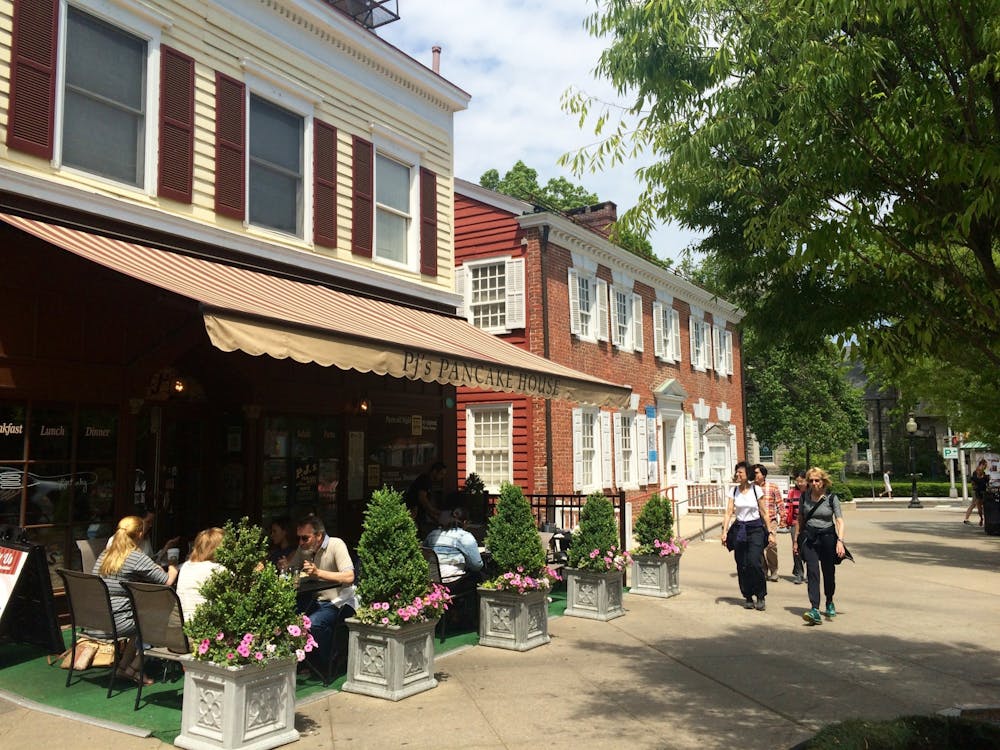Anyone who thinks art and science don't mix should take a trip to the Lewis-Sigler Institute for Integrative Genomics. The new building is home to a mammoth sculpture by world-renowned architect Frank Gehry.
The 40-foot by 25-foot lead shell swells and dips, supported by what appears to be a delicate frame of curved wood strips. It houses a kind of conference room — complete with ergonomic swivel chairs. Take a seat at the table and it feels like being inside the belly of a great whale — only it's snug, not creepy. More like a womb, really.
But more than the experience of the sculpture itself, the story of its acquisition is fascinating. It is the story of collaboration between two men – one, a financier and the other, a creative thinker. They are, respectively, Peter Lewis '55, a trustee of the University, and Gehry.
"[The sculpture] reflects the very strong and important relationship between Mr. Lewis and Mr. Gehry that has played such a central role in the development of Mr. Gehry's career. In that sense, it's a very important object," Wright said. "It has a very important and interesting history."
Gehry's sculpture is the product of more than two decades of experimentation made possible by Lewis, according to Thomas Wright '62, Vice President and Secretary of the University. Lewis commissioned Gehry to design a private home for him some 20 years ago — a home that was never built.
"Many models were built, many designs were made, many millions of dollars were paid by Mr. Lewis, so that Frank Gehry could work on these ideas and develop them," Wright said.
An exhibition of Gehry's work at the Guggenheim Museum in New York City one year ago made it clear his ideas took off in "a whole new direction" during the years he received financial support from Lewis to design this house, according to Wright. Lewis' commission and subsequent backing brought Gehry where he is today and essentially helped create the sculpture placed in the genomics building.
According to a November 2001 posting on the Princeton Web, Gehry's work "often features bold, curved shapes that seem to defy the physical limitations of ordinary building materials."

The sculpture in the genomics building references Gehry's vision for Lewis' house, as well as a German bank he designed, Wright said.
"If you saw the [bank], or if you saw designs or pictures of the [bank], you'd be very surprised how similar some of the elements are of the two," he explained.
The sculpture was not commissioned for the genomics building, but rather belonged to Lewis, who approached Wright and Harold Shapiro, former president of the University, about finding a place to put it.
"Mr. Lewis came to President Shapiro and myself a couple of years ago with some pictures of this sculpture, which was all then broken apart in pieces and in a warehouse in California. And it was not assembled. It had been assembled once, but then it was disassembled and boxed up and put in a warehouse," Wright said.

The sculpture couldn't be placed outside — it's lead and wood cannot be exposed to the weather. Obviously, a pretty large space was needed to accommodate it. And a serendipitous thing happened to allow for that.
Rafael Vinoly, the architect who designed the Lewis-Sigler Institute, had just come up with his initial concept for the building, according to Wright, who was also involved in its construction.
"I knew that Mr. Vinoly was imagining a very large interior space and it occurred to me that, possibly, this new building that was going to be built could be a wonderful location for the Gehry sculpture," Wright said.
Wright felt slightly uncomfortable approaching about placing Gehry's sculpture in his building. One artist (in the broad sense of the word) often finds it difficult to have his work associated with that of another artist, Wright noted. But Vinoly was delighted by the idea as was Gehry.
"And so it's a remarkable story, really. It's a very important object and I think it's now in a wonderful place," Wright said.
"It's very nice to be in there. The acoustics are very good. Being in there at the table, I think, is a very pleasant experience."
There was talk of putting a serving area for coffee and vending inside the sculpture, but that proved infeasible, according to Wright. It will remain a conference area.
Gehry also designed the science library in the genomics buildings, made possible possible by Lewis' $60 million gift. His previous work includes the Guggenheim Museum Bilbao in Bilbao, Spain.
Gehry received the Pritzker Prize for Architecture in 1989 and the American Institute of Architects Gold Medal in 1999.







